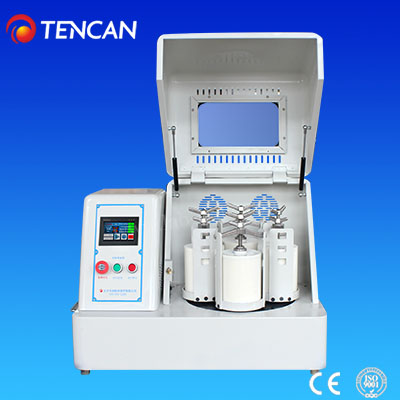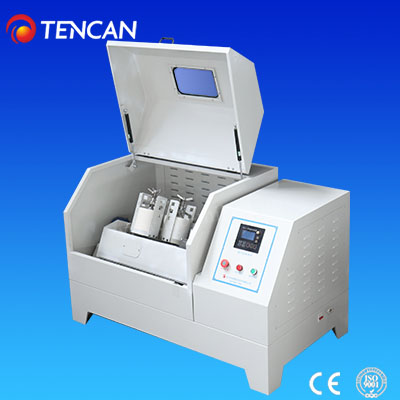Planetary ball mills are the workhorses of material processing, capable of grinding down materials to the nanometer scale.
But before you embark on your journey into the ultra-fine world, a crucial question arises: how much do these machines cost? Unlike a simple price tag, the answer involves understanding a spectrum of factors that influence the cost of a planetary ball mill.
 Planetary ball mills aren't a one-size-fits-all solution, and their price reflects that. The cost can range anywhere from {Insert low price range based on your research} for a basic benchtop model to a hefty {Insert high price range based on your research} for a high-capacity industrial mill. So, what exactly determines the price tag on these powerful grinders?
Several key elements influence the cost of a planetary ball mill:
Mill Size and Capacity: Just like any machine, size matters. Larger mills designed for high-volume processing naturally cost more than their compact benchtop counterparts. If you're dealing with smaller samples, a benchtop model might be sufficient and more affordable.
Feature Frenzy: The more bells and whistles, the higher the price tag. Advanced features like variable speed control, programmable operation, or integrated cooling systems add value but also add to the cost. Identify the features essential for your application and avoid paying for functionalities you won't use.
Planetary ball mills aren't a one-size-fits-all solution, and their price reflects that. The cost can range anywhere from {Insert low price range based on your research} for a basic benchtop model to a hefty {Insert high price range based on your research} for a high-capacity industrial mill. So, what exactly determines the price tag on these powerful grinders?
Several key elements influence the cost of a planetary ball mill:
Mill Size and Capacity: Just like any machine, size matters. Larger mills designed for high-volume processing naturally cost more than their compact benchtop counterparts. If you're dealing with smaller samples, a benchtop model might be sufficient and more affordable.
Feature Frenzy: The more bells and whistles, the higher the price tag. Advanced features like variable speed control, programmable operation, or integrated cooling systems add value but also add to the cost. Identify the features essential for your application and avoid paying for functionalities you won't use.
 Grinding Media Matters: The type of grinding media used within the mill can also play a role. For example, mills equipped with high-performance grinding media like yttria-stabilized zirconia (YSZ) may cost more than those using standard stainless steel balls. YSZ offers superior wear resistance and contamination prevention, which can be crucial for specific applications.
Brand Power: Established manufacturers with a reputation for quality and reliable mills may command a premium price compared to lesser-known brands. While brand recognition can be a marker of quality, carefully evaluate the features and performance of the mill itself before solely relying on brand name.
So, how do you find the perfect balance between affordability and functionality? Here are some tips:
Define Your Needs: Before diving into the market, clearly define the size and capacity of the mill required for your specific application. Consider the desired level of automation, the types of materials you will be grinding, and the required particle size distribution.
Manufacturer Matchmaking: Research different manufacturers, comparing features, capacities, and pricing. Read online reviews and user testimonials to gain insights into the performance and reliability of different models. Don't be afraid to contact manufacturers directly to discuss your needs and get quotes.
Grinding Media Matters: The type of grinding media used within the mill can also play a role. For example, mills equipped with high-performance grinding media like yttria-stabilized zirconia (YSZ) may cost more than those using standard stainless steel balls. YSZ offers superior wear resistance and contamination prevention, which can be crucial for specific applications.
Brand Power: Established manufacturers with a reputation for quality and reliable mills may command a premium price compared to lesser-known brands. While brand recognition can be a marker of quality, carefully evaluate the features and performance of the mill itself before solely relying on brand name.
So, how do you find the perfect balance between affordability and functionality? Here are some tips:
Define Your Needs: Before diving into the market, clearly define the size and capacity of the mill required for your specific application. Consider the desired level of automation, the types of materials you will be grinding, and the required particle size distribution.
Manufacturer Matchmaking: Research different manufacturers, comparing features, capacities, and pricing. Read online reviews and user testimonials to gain insights into the performance and reliability of different models. Don't be afraid to contact manufacturers directly to discuss your needs and get quotes.
 Considering Pre-Owned Options: Reputable companies often sell used or refurbished planetary ball mills at a significantly lower price. This can be a great option if you are on a tight budget. Just ensure the pre-owned equipment is in good working condition and comes with a warranty.
While price is an important factor, remember that a planetary ball mill is a long-term investment. Focus on finding a mill that offers the features, capacity, and performance you need for your application. Reliable and durable mills may have a higher upfront cost, but they can save you money in the long run by minimizing downtime and maintenance requirements.
The cost of a planetary ball mill is a journey, not a destination. By understanding the factors affecting price and defining your requirements, you can make an informed decision. Remember, the goal is to find a mill that delivers exceptional grinding performance while staying within your budget. With careful planning and research, you can unlock the world of ultra-fine materials without breaking the bank.
Considering Pre-Owned Options: Reputable companies often sell used or refurbished planetary ball mills at a significantly lower price. This can be a great option if you are on a tight budget. Just ensure the pre-owned equipment is in good working condition and comes with a warranty.
While price is an important factor, remember that a planetary ball mill is a long-term investment. Focus on finding a mill that offers the features, capacity, and performance you need for your application. Reliable and durable mills may have a higher upfront cost, but they can save you money in the long run by minimizing downtime and maintenance requirements.
The cost of a planetary ball mill is a journey, not a destination. By understanding the factors affecting price and defining your requirements, you can make an informed decision. Remember, the goal is to find a mill that delivers exceptional grinding performance while staying within your budget. With careful planning and research, you can unlock the world of ultra-fine materials without breaking the bank.
